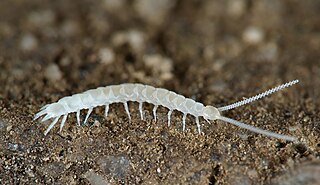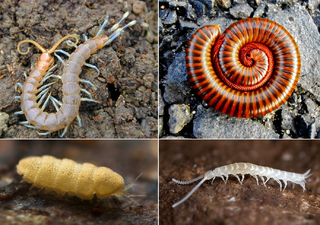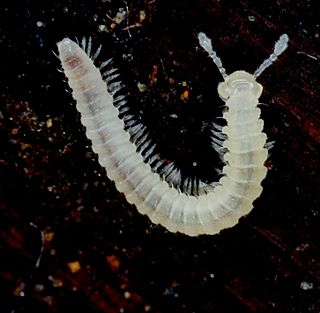
Pauropoda is a class of small, pale, millipede-like arthropods in the subphylum Myriapoda. More than 900 species in twelve families are found worldwide, living in soil and leaf mold. Pauropods look like centipedes or millipedes and may be a sister group of the latter, but a close relationship with Symphyla has also been posited. These arthropods have been named pauropods because most species in this class have only nine pairs of legs as adults, a smaller number than those found among adults in any other class of myriapods.

Symphylans, also known as garden centipedes or pseudocentipedes, are soil-dwelling arthropods of the class Symphyla in the subphylum Myriapoda. Symphylans resemble centipedes, but are very small, non-venomous, and only distantly related to both centipedes and millipedes. More than 200 species are known worldwide.

Myriapods are the members of subphylum Myriapoda, containing arthropods such as millipedes and centipedes. The group contains about 13,000 species, all of them terrestrial.

Pauropodidae is the most diverse family of pauropods, containing 27 genera and more than 800 species, as well as the only known fossil pauropod, Eopauropus. This family has a subcosmopolitan distribution. Pauropods in this family are generally whitish and feature a sternal antennal branch with one seta and one globulus, setae on the head and tergites that are usually tapering or cylindrical, and a single anal plate. Like most adult pauropods in the order Tetramerocerata, most adults in this family have 9 pairs of legs, but adults in one genus, Cauvetauropus, have only 8 pairs of legs, and female adults in another genus, Decapauropus, have either 9 or 10 pairs of legs. The first species found to include pauropods with more than 9 pairs of legs was D. cuenoti, first described with 10 pairs in 1931.

Glomerida is an order of pill-millipedes found primarily in the Northern Hemisphere. Also known as northern pill millipedes, they superficially resemble pill-bugs or woodlice, and can enroll into a protective ball. They have twelve body segments, 17 to 19 pairs of legs, and males have enlarged rear legs involved in mating. The order includes about 30 genera and at least 280 species, including Glomeris marginata, the common European pill-millipede. The order contains members in Europe, South-east Asia and the Americas from California to Guatemala. Although historically considered closely related with the similar sphaerotheriidans that also enroll, some DNA evidence suggest they may be more closely related to glomeridesmidans, a poorly known order that does not enroll.

Polyxenidae is a family of millipedes in the order Polyxenida containing approximately 47 species in 19 genera. Adults in all species in this family have 13 pairs of legs.
Millotauropus is a genus of pauropods in the monotypic family Millotauropodidae in the monotypic order Hexamerocerata. The order Hexamerocerata includes only eight species and was created in 1950 to contain the newly discovered genus Millotauropus, which was found to have so many distinctive features as to warrant placement in a separate order. Before the discovery of Millotauropus, for example, pauropods were thought to have no more than ten leg pairs, but adults in the order Hexamerocerata have eleven pairs of legs.
Tetramerocerata is an order of pauropods containing 11 families and more than 900 species. This order was created in 1950 to distinguish these pauropods from those in the newly discovered genus Millotauropus, which was found to have such distinctive features as to warrant placement in a separate order (Hexamerocerata) created to contain that genus. The order Tetramerocerata includes the vast majority of pauropod species, as there are only eight species in the order Hexamerocerata, which remains the only other order in the class Pauropoda.
Eopauropus balticus is a prehistoric pauropod known from mid-Eocene Baltic amber. It is the only known pauropod in the fossil record. As pauropods are normally soil-dwelling, their presence in amber is unusual, and they are the rarest known animals in Baltic amber.
Linotaeniidae are a monophyletic clade of soil centipedes in the family Geophilidae found mostly in the temperate regions of the Holarctic as well as the south Andes. Species in the clade Linotaeniidae are characterized by a body that usually tapers toward the anterior tip; mandibles with a single pectinate lamella; second maxillae with coxo-sternite usually undivided and claws without projections; forcipular segment short, with tergite remarkably wide, forcipules evidently tapering; coxal organs opening through distinct pores on the ventral surface of the coxo-pleura. The number of legs in this clade varies within as well as among species and ranges from as few as 31 pairs of legs to as many as 83 leg pairs. Compared to most families in the suborder Adesmata, this clade features a modest number of leg-bearing segments and limited variation in this number within each species.

Schendylidae is a family of centipedes in the order Geophilomorpha found in the Americas, the Palearctic region, Africa, Madagascar, Australia, and southeast Asia, and also on some Pacific islands.

Conotylidae is a family of millipedes in the order Chordeumatida. Adult millipedes in this family have 30 segments. There are about 19 genera and at least 60 described species in Conotylidae.

Striariidae is a family of millipedes in the order Chordeumatida. Adult millipedes in this family have 30 segments. There are at least 3 genera and about 13 described species in Striariidae.

Scolopendrellidae is a family of symphylans in the class Symphyla. There are about 9 genera and at least 100 described species in Scolopendrellidae.

Scutigerellidae is a family of pseudocentipedes in the class Symphyla. There are about 5 genera and at least 140 described species in Scutigerellidae.

Metopidiotrichidae is a family of millipedes in the order Chordeumatida. These millipedes range from 4 mm to 17 mm in length. Adult millipedes in this family have 32 segments, not the 30 segments usually found in this order. Adult males in this family often feature a reduced or vestigial leg pair 10 as part of the gonopod complex, in addition to the two leg pairs typically modified into gonopods in this order. There are about 9 genera and at least 70 described species in Metopidiotrichidae.
Chordeumatidae is a family of millipedes belonging to the order Chordeumatida. These millipedes range from 7 mm to 18 mm in length and are found in Europe. Adult millipedes in this family have either 28 or 30 segments. This family features distinctive sex-linked modifications to the legs in adults: In the adult female, a legless sternite replaces the third pair of legs, and in the adult male, five pairs of legs are modified in the gonopod complex. These modifications are more extensive than those found in other adult males in this order, which often have only two leg pairs modified into gonopods. With the more extensive modifications to the legs in this family, species with the usual 30 segments feature adult females with only 49 leg pairs and adult males with only 45 pairs of walking legs, and species with only 28 segments feature adult females with only 45 leg pairs and adult males with only 41 pairs of walking legs.
Hoffmaneumatidae is a family of millipedes belonging to the order Chordeumatida. This family includes two genera, one (Hoffmaneuma) found in the Russian Far East and the other (Japanoparvus) found in Japan. Millipedes in this family range from 4 mm to 6 mm in length. Adult millipedes in this family have only 28 segments, not the 30 segments usually found in this order. Adult males in this family feature a reduced leg pair 10 in addition to the two pairs normally modified into gonopods in this order. In the adult male of the species Hoffmaneuma exiguum, for example, the gonopod complex derives from all three leg pairs rather than from just the usual two.
Zygopauropus is a monotypic genus of pauropod in the family Brachypauropodidae. The only species in this genus is Zygopauropus hesperius, first described by J.W. MacSwain and U.N. Lanham of the University of California at Berkeley in 1948. This genus is notable as one of only four genera of pauropods in which adults have only eight pairs of legs rather than the nine leg pairs usually found in adults in the order Tetramerocerata. Before the discovery of Z. hesperius, adult pauropods were thought to have only nine or (rarely) ten pairs of legs.
Decapauropus is a large genus of pauropods in the family Pauropodidae that includes more than 300 species. This genus was originally described by Paul Remy in 1931 to contain the newly discovered type species Decapauropus cuenoti. As the name of this genus suggests, this genus is notable for including females with ten pairs of legs instead of the nine leg pairs usually found in adult pauropods in the order Tetramerocerata. Before the discovery of D. cuenoti, adult pauropods were thought to have invariably nine pairs of legs.











